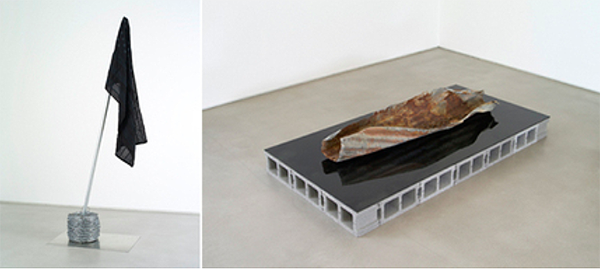MY AIM was to handle the object head-on, explicitly, which is why I built things around detritus from the desert––a rusted metal husk, a wooden palette, road 'gators,' yucca leaves. Transported to the white cube, the litter, elevated there to the status of the object, becomes venerated, talismanic, or consecrated. It’s about the recuperation of objects––or what remains of them. This opened a way forward, like crossing a frontier.
A fundamental American mythology is that people go West to reinvent themselves, to construct new identities, and establish their own laws in a lawless world. Wire fences were put up across the West in the 1870s, and boundaries are still being contested and reinforced there. When we talk about the border, which is an arbitrary line, it’s about the Comanche and the drug cartels, violence, a frontier, the in-between, self and other. Much of my current work has to do with crossing, a traversing.
The show also refers to the body, especially as a link between land and sky. References to the head abound––off the shoulders, separated. For me, the piece
House of Asterion, the one with the driftwood set against the bleached-splattered denim canvas, and hung against corrugated metal panels, echoes Courbet’s
Origin of the World. It’s like the birth of the universe, a new world, virgin land––maybe the ultimate effect of having made a name for myself, Buck.
Maybe my name change has to do with storytelling. An artist’s relationship to the object bears his own individual stamp, or insignia. Any exhibition or work has a relationship to fantasy, the invention of an imaginary world. A better word for story may be construction, which beautifully refers to the type of materials I used. The story I’ve been telling has expanded, for instance: instead of autobiographical references to my father, they’re now to 'fatherland'; not to my childhood home, but to 'homeland'; not the signifier the West, but a semblance of it, “Kahpenakwu.”
Making art is a way to contend with the “real,” as defined by the early teachings of Lacan––the hole or void––whatever you wish to call it. In the work, grids function like a screen to cover it. In the “Second Hand” series, for instance, I draw grids on thrift store paintings to enlarge a signature from one of my previous exhibition guestbooks. It’s like a trellis or scrim between myself and the other––both the painter of the found canvas and the person who signed their name in the guestbook. The name, which is inherited––in psychoanalysis the Name-of-the-Father––is also 'secondhand,' and on it our identities are grafted.
'On and off the grid' was another signifier I wanted to toy with in the show. The concrete, modular elements––cinderblocks, pavers, screen blocks––in the sculptures are building materials often used in “off the grid” architecture and cipher modernism. The smoked Plexiglas surfaces, all of which mask an image (as in
El Camino Real or
An Eye for an Eye for an Eye for an Eye for instance), are shorthand for Gorilla Glass, the sheet glass manufactured by Corning for portable electronic devices, and they evoke the hypermodern. The grid is degree-zero––from GPS to the pixel––where bodies and desires all have coordinates and can be 'mapped.'
For the first time, I don’t mind being associated with certain signifiers. If links are now made to the desert, off the grid, psychoanalysis, the Name-of-the-Father, self-invention, fine! Maybe this is something artists especially must bear, that certain signifiers will forever be ascribed to them.
As artists, we want to be working at the border of what is known. How else can we begin but by making furrows in the unknown? The only way to do this is to 'know' that the mark you make will be yours, yours alone.
— As told to Matthew Porter
Left:
Through the Night That, 2011, dyed US flag, barbed wire, metal pole and metal plate, 95 x 40 1/2 x 24“ Right:
the crossing over and/or the crossing out, 2011, cinder blocks, rusted corrugated metal panel, lechuguilla pods, Plexiglas face-mounted photograph, 18 3/4 x 93 1/2 x 47”
Robert Buck © 2012
Download



